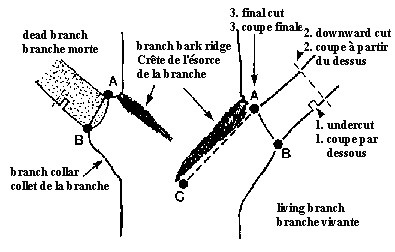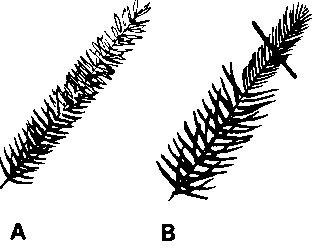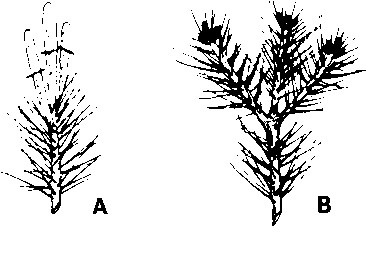Agdex No. 275.24
Pruning is the removal of selected living or dead parts of a plant to maintain appearance, health, and to regulate growth. It is used to improve structural strength, safety and access to trees. There are no strict rules for pruning as each tree should be pruned to enhance its natural growth habit.
It is important to choose an appropriate location for a tree to reduce the risk of damage to houses and power lines. Always consider the mature sizes of plants. If the correct size plant is used drastic pruning will not be required to keep a plant in its space. Most trees do not require extensive pruning on a yearly basis.
Shade Trees
It is necessary when pruning shade trees to remove any dead or diseased wood. The natural structure of the tree should be maintained but tightly spaced or crossed branches should be removed. Narrow crotch angles between the trunk and branch are structurally weak so these branches are the first to break in a strong wind or if a heavy load is placed on them. Smaller pruning cuts are easier to make and heal faster.
The best time to prune most trees is when the tree is still dormant in early spring. (Spring pruning of several species such as birch, maple and grape causes the loss of a great deal of sap. These species should be pruned in late spring after leaves are normal size.)
Pruning Cut
A double cut method should be used to remove any large branches to avoid damaging the bark of the tree. An undercut (Fig.1 no.1) about 30 cm from the trunk and then a downward cut ( Fig. 1 no. 2) is made 35 cm from the trunk to remove the branch. The third and final cut (from A to B) will remove the branch stub and make a clean smooth wound that will heal quickly. This method accelerates healing, forming a ring of callus completely around the wound the first growing season after a cut is made. Cuts made flush with the tree trunk do not heal as well.
Do not leave large stubs as they prevent proper healing and allow pathogens to enter the tree. Wound dressings are not necessary if a proper cut is made. The tree will heal and protect itself without a dressing.
Evergreen trees
Evergreen trees do not develop new growth from old wood so heavy pruning is not effective to rejuvenate them. If a whole branch is removed an open space will remain in the tree. Spruce, pine, fir, ect., once they are established usually only require pruning to remove dead or diseased branches as they maintain their natural conical shape with little help.
Pine
Pines are pruned in the spring at the 'Candle stage' when the needles of the young shoots are still packed tightly around the stem. These candles can be cut back by half (Fig. 2) and new buds will form at the cut end.
Spruce and Fir
Fast growing spruce and fir tree will sometimes develop large spaces between the whorls of branches and a very long leader. These bare spaces can be reduced by cutting the central leader to about half of its size during the active spring growth period (Fig. 3). Fast growing laterals can also be treated in the same way or the terminal bud can be removed to control size. If more size control is required, the lateral can be cut back to an inner bud.
These species can also be sheared if used for hedges or a very dense tree is wanted. Shearing can be done once new buds are set, usually after mid-July.
Figure 1 The pruning cut. La taille



